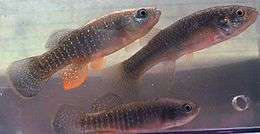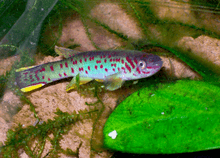Cyprinodontiformes
| Cyprinodontiformes Temporal range: Oligocene–recent | |
|---|---|
 | |
| Mummichog (Fundulus heteroclitus heteroclitus) Female (top right) and two males | |
| Scientific classification | |
| Kingdom: | Animalia |
| Phylum: | Chordata |
| Superclass: | Osteichthyes |
| Class: | Actinopterygii |
| Subclass: | Neopterygii |
| Infraclass: | Teleostei |
| Superorder: | Acanthopterygii |
| Order: | Cyprinodontiformes L. S. Berg, 1940 |
| Suborders | |
|
Aplocheiloidei | |
| Synonyms | |
|
Microcyprini Regan, 1909 | |
Cyprinodontiformes /ˌsaɪprᵻnoʊˌdɒntᵻˈfɔːrmiːz/ is an order of ray-finned fish, comprising mostly small, freshwater fish.[1] Many popular aquarium fish, such as killifish and live-bearers, are included. They are closely related to the Atheriniformes and are occasionally included with them. A colloquial term for the order as a whole is toothcarps, though they are not actually close relatives of the true carps – the latter belong to the superorder Ostariophysi, while the toothcarps are Acanthopterygii.
The families of Cyprinodontiformes can be divided into three groups: viviparous and ovoviviparous (all species give live birth), and oviparous (all species egg-laying). The live-bearing groups differ in whether the young are carried to term within (ovoviviparous) or without (viviparous) an enclosing eggshell. Phylogenetically however, one of the two suborders – the Aplocheiloidei – contains oviparous species exclusively, as do two of the four superfamilies of the other suborder (the Cyprinodontoidea and Valencioidea of the Cyprinodontoidei). Vivipary and ovovivipary have evolved independently from oviparous ancestors, the latter possibly twice.
Description

Members of this order are notable for inhabiting harsh environments, such as saline or very warm waters, water of poor quality, or isolated situations where no other types of fish occur. They are typically omnivores, and often live near the surface, where the oxygen-rich water compensates for environmental disadvantages.
They are small to medium-sized fish, with small mouths, large eyes, a single dorsal fin, and a rounded caudal fin. The largest species is the cuatro ojos (Anableps dowi), which measures 34 cm (13 in)[2] in length, while the smallest, the least killifish (Heterandria formosa), is just 8 mm (0.31 in) long as an adult.[3]
Systematics

CYPRINODONTIFORMES
- Suborder Aplocheiloidei (all oviparous)
- Family Aplocheilidae – African, Asian and South American killifishes [4]
- Suborder Cyprinodontoidei
- Superfamily Funduloidea (oviparous)
- Family Profundulidae – Central American killifishes (oviparous)
- Family Goodeidae – splitfins (viviparous)
- Family Fundulidae – topminnows and North American killifishes (oviparous)
- Superfamily Valencioidea (oviparous)
- Family Valenciidae – Mediterranean killifishes
- Superfamily Cyprinodontoidea (oviparous)
- Family Cyprinodontidae – pupfishes
- Superfamily Poecilioidea
- Family Anablepidae – four-eyed fishes and relatives (ovoviviparous)
- Family Poeciliidae – livebearers and relatives (some oviparous, some ovoviviparous)
- Superfamily Funduloidea (oviparous)
References
| Wikimedia Commons has media related to Cyprinodontiformes. |
- ↑ Froese, Rainer, and Daniel Pauly, eds. (2007). "Cyprinodontiformes" in FishBase. August 2007 version.
- ↑ http://www.discoverlife.org/mp/20q?search=Anableps+dowi&flags=col3:&res=320
- ↑ Parenti, Lynne R. (1998). Paxton, J.R.; Eschmeyer, W.N., eds. Encyclopedia of Fishes. San Diego: Academic Press. pp. 148–151. ISBN 0-12-547665-5.
- ↑ Costa, W.J.E.M. (2016): Comparative morphology and classification of South American cynopoeciline killifishes (Cyprinodontiformes: Aplocheilidae), with notes on family-group names used for aplocheiloids. Vertebrate Zoology, 66 (2): 125-140.